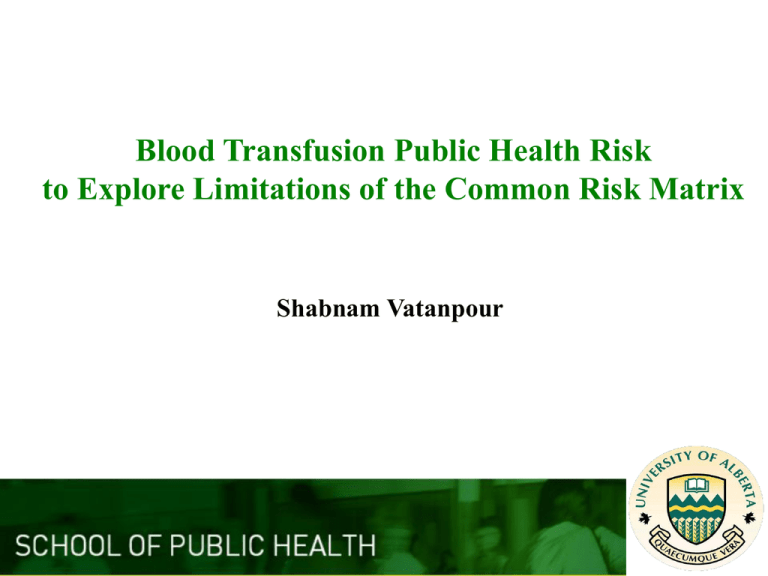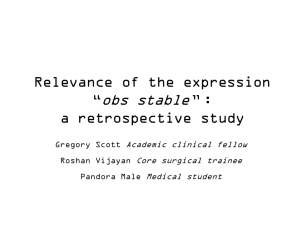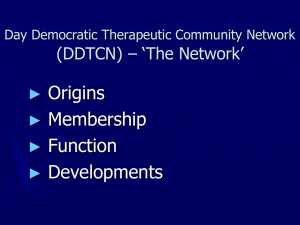
Blood Transfusion Public Health Risk
to Explore Limitations of the Common Risk Matrix
Shabnam Vatanpour
Outline
•
•
•
•
•
Background
Objectives
Methods
Results
Conclusions
Risk Management
ISO International Standard
Monitoring
& review
Communication
& consultation
Risk
treatment
Establishing
the context
Risk
Risk
Assessment
Assessment
Risk Matrix
*U.K.
National Health Service Guidance
Simple to use
Capable of
assessing a broad
range of risks
Consistent
Simple to adapt
to meet specific
needs
Risk Matrix
Cox’s Concerns
Ambiguous
inputs and
outputs
Poor
resolution
Sub-optimal
allocation of
resources
In some
situations,
worse than a
random guess
Cox’s Theoretical Example
Risk = Frequency × Severity
where
Frequency = 0.75 – Severity
(for severity between 0 and 0.75)
Severity
Frequency
1
High
Low
High
0.5
0
1
Medium
High
Low
Medium
0.5
Low
0
Negative Correlation
Frequency
Severity
[0,0.25] → [0.5,0.75] Medium
[0.25,0.5] → [0.25,0.5] Low
1 [0.5,0.75] → [0,0.25]
Medium
0.9
Risk (Frequency × Severity) = F × S
0.8
Risk (0.45, 0.3) =0.13 → Low risk
Risk ( 0.32,0.43) =0.14 → Low risk
Risk (0.1, 0.65)=0.07 → Medium risk
Risk (0.55, 0.2) =0.11 → Medium risk
Risk
0.7
0.6
0.5
0.4
Low
0.3
Medium
Medium
0.2
0.1
0
0
0.2
0.4
0.6
Frequency
0.8
1
Objective
Evaluation of risk matrix
• using a public health risk scenario
tainted blood transfusion risk
• when frequency and severity are
negatively correlated
Methods
Data collection: (Frequency, Severity)
Assess relationship between frequency
and severity
Fit an appropriate risk curve to
frequency and severity & estimate risks
Construct risk matrix and assign risk
levels
Compare risk levels and estimated risks
Severity and Frequency of Blood Infectious Diseases in
Canada, 1987-1996
Infectious
Severity
Diseases
Severity
Frequency
Category
Frequency
Source
Category
HIV
105
Very High
0.000001
Extremely Low
Blood Donors
HTLV
104
High
0.0000008
Extremely Low
Blood Donors
Hepatitis B
103
Medium
0.00001
Very Low
Blood Donors
Hepatitis C
103
Medium
0.000004
Extremely Low
Blood Donors
Hepatitis G
10
Very Low
0.01
High
Blood Donors
Bacterial
102
Low
0.000026
Very Low
Blood Donors
Cytomegalovirus
102
Low
0.4
Very High
Blood Donors
Epstein-Barr virus
102
Low
0.9
Very High
Blood Donors
TT virus
10
Very Low
0.3
Very High
Blood Donors
SEN virus
10
Very Low
0.02
High
Blood Donors
CJD/vCJD
105
Very High
0.000001
Extremely Low
Population
Syphilis
104
High
0.000006
Extremely Low
Blood Donors
Contamination
National Health Service Criteria
National Health Service Criteria
Results
Negative correlation
Spearman correlation: -0.81
Logarithmic transformation
log-Risk = log-Frequency + log-Severity
Relationship between frequency and severity
log-Severity = 0.24 log-Frequency2 + 1.01 log-Frequency +1.99
Risk function estimation
log-Risk = 1.99 + 2.01 log-Frequency + 0.24 log-Frequency2
4
Risk = Frequency x Severity
2
Epstein-Barr virus
0
TT virus
HIV
-2
CJD/vCJDC
SEN virus
Syphilis
Hepatitis G
Hepatitis B
HTLV
Hepatitis C
Bacterial Contamination
Fitted curve
Observations
-4
log-Risk
Cytomegalovirus
-6
-4
-2
log-Frequency
0
Blood Infectious Diseases
Frequency of
Risk Matrix
Infection
Observed risk:
Risk = Frequency × Severity
Estimated risk:
log-Risk = 1.99 + 2.01 logFrequency + 0.24 log-Frequency2
Severity of consequences
Very Low
Low
Very High
TT virus
†Obs 3 ‡Est 10
Cytomegalovirus
†Obs 35 ‡Est 13
Epstein-Barr
virus †Obs 90
‡Est 79
High
SEN virus
†Obs 0.2 ‡Est
0.19 Hepatitis
G
†Obs
0.11 ‡Est 0.10
Medium
High
Very High
Syphilis
†Obs 0.06
‡Est 0.01
HTLV
†Obs 0.01
‡Est 0.05
HIV
†Obs 0.13
‡Est 0.03
CJD/vCJD
†Obs 0.1
‡Est 0.04
Medium
Low
Risk Color Coding
Low
Medium
High
Very
High
Very Low
Extremely
Low
Bacterial
contamination
†Obs 0.003
‡Est 0.007
Hepatitis B
†Obs 0.01
‡Est 0.01
Hepatitis C
†Obs 0.004
‡Est 0.014
†Risk estimation based on the fitted risk function
‡Observed risk based on the risk generic function
Risk Estimation
Risk{(Hep B,10-5, 103)} = 0.01
Risk{(TT, 0.3, 10)} =10
Risk{(Ep. Barr, 0.9, 100)} = 79
Low Risk
Low Risk
Medium Risk
Higher risk diseases
tend to have higher risk ranks in the risk matrix.
4
Generating Data
Frequency
Risk
Severity
Epstein-Barr virus
2
Generated
Data
0.00003
0.0003
10
Data 2
0.00021
0.21
1000
0.00006
0.0006
CJD/vCJDC
10
0.005
0.5
SEN virus
Syphilis
Hepatitis B
HTLV
Hepatitis C
100
Hepatitis G
Bacterial Contamination
Generated data 3
Generated data 1
-4
Data 4
TT virus
Generated data 2
HIV
-2
Data 3
Generated data 4
0
Data 1
log-Risk
Cytomegalovirus
-6
-4
-2
log-Frequency
Fitted curve
Observations
0
Blood Infectious Diseases
Frequency
Risk Matrix
Observed risk:
Risk = Frequency × Severity
Estimated risk:
log-Risk = 1.99 + 2.01 logFrequency + 0.24 log-Frequency2
Severity
Very Low
Low
Very High
TT virus
†Obs 3 ‡Est 10
Cytomegalovirus
†Obs 35 ‡Est 13
Epstein-Barr virus
†Obs 90 ‡Est 79
High
SEN virus
†Obs 0.2 ‡Est 0.19
Hepatitis G
†Obs 0.11 ‡Est
0.10
*Generated
Medium
Low
Medium
High
Very High
Syphilis
†Obs 0.06
‡Est 0.01
HTLV
†Obs 0.01
‡Est 0.05
HIV
†Obs 0.13
‡Est 0.03
CJD/vCJD
†Obs 0.1
‡Est 0.04
data 4
‡Est 0.50
*Generated
*Generated
data 3
‡Est 0.0006
data 2
‡Est 0.21
Risk Color Coding
Low
Medium
High
*Generated
Very
High
Very Low
Extremely Low
data 1
‡Est 0.0003
Bacterial
contamination
†Obs 0.003
‡Est 0.007
Hepatitis B
†Obs 0.01
‡Est 0.01
Hepatitis C
†Obs 0.004
‡Est 0.014
†Risk estimation based on the fitted risk function
‡Observed risk based on the risk generic function
Risk Estimation
Generated Data
Risk{(Hep B,10-5, 103)} = 0.01
Risk{(TT, 0.3, 10)} =10
Risk{(Data 2, 0.00021, 103)} = 0.21
Risk{(Data 4, 0.005, 100)} = 0.5
Low Risk
Low Risk
Medium Risk
Medium Risk
Higher risk diseases
tend to have lower risk ranks in the risk matrix
for some scenarios.
Conclusions
• Careful reconsideration of uses of the risk matrix in
risk management
• Use risk matrix outputs as an operational input to risk
management decision-making,
• Avoid risk matrix outputs to drive or even become the
risk management decision.
Reference
1.
2.
3.
4.
5.
6.
7.
8.
9.
10.
11.
12.
13.
14.
15.
16.
17.
18.
19.
20.
21.
22.
23.
Cox LA Jr. What's wrong with risk matrices? Risk Anal. 2008; 28(2):497-512.
Government of Alberta. 2012. Drinking Water Safety Plan Training Course. Alberta Environment and Sustainable Resource Development.
http://environment.gov.ab.ca/info/library/8691.pdf
Hrudey, S.E., E. J. Hrudey. 2004. Safe Drinking Water - Lessons from Recent Outbreaks in Affluent Nations. London, IWA Publishing.
Hrudey, S.E., D. Krewski. 1995. "Is there a safe level of exposure to a carcinogen?" Environ. Sci. Technol. 29(8), 370A-375A.
Hrudey, S.E. 1995. “Major concerns with quantitative cancer risk assessment for environmental risk management: North American experience.” Process Safety Environ.
Protect. - Trans. I. Chem. E. 73, Part B, S24-S27.
Hrudey, S.E. 1998. “Quantitative Cancer Risk Assessment - Pitfalls and Progress.” Issues in Environmental Science and Technology.Eds. R.E. Hester and R.M. Harrison
9: 57-90, Roy. Soc. Chem. Pub., Cambridge
Hubbard, D., D. Evans. 2010. Problems with scoring methods and ordinal scales in risk assessment. IBM Journal of Research & Development. 54(3): 2:1-2:10.
ISO 2009. International Standard: Risk management – Risk assessment techniques. IEC/ICO 31010. Edition 1.0 2009-11
Kaplan S, Garrick BJ: On the quantitative definition of risk. Risk Analysis. 1981, 1:11-27.
Levine, E.S. 2012. Improving risk matrices: the advantages of logarithmically scaled axes. Journal of Risk Research. 15(2): 209-222.
NHMRC. 2011. Australian Drinking Water Guidelines. National Health and Medical Research Council. Canberra, ACT.
http://www.nhmrc.gov.au/guidelines/publications/eh52
NHS NPSA 2008.A Risk Matrix for Risk Managers. National Patient Safety Administration, National Health Service. London, U.K.
Pickering, A., S. Cowley. 2010. Risk matrices: implied accuracy and false assumptions. Journal of Health & Safety Research & Practice. 2(1): 9-16.
Queensland Health 2012. Implementation Standard for Use of the Risk Analysis Matrix. Standard #QH-IMP-070-2:2011.
Quintella, M.C., M. Addas-Carvalho and M.G.C. daSilva. 2008. Evaluation of the risk analysis technique in Blood Bank Production Processes. Chemical Engineering
Transactions. 13: 271-278.
Risk Management: Principles and Guidelines. 2009. Available at: http://www.iso.org/iso/catalogue_detail?csnumber=43170 . Accessed
Rodricks, J.V. 2007. Has quantitative risk assessment been of benefit to the science of toxicology? 2006 American College of Toxicology distinguished service award
lecture. International Journal of Toxicology 26: 3–12.
TBC 2013. Treasury Board Secretariat of Canada. Guide to Corporate Risk Profiles. http://www.tbs-sct.gc.ca/tbs-sct/rm-gr/guides/gcrp-gepropr-eng.asp?format=print
US DOT 2006. Risk Assessment and Allocation for Highway Construction Management. Federal Highway Administration. U.S. Department of Transport. October 2006
http://international.fhwa.dot.gov/riskassess/index.cfm
WHO 2012. Rapid Risk Assessment of Acute Public Health Events. World Health Organization. WHO/HSE/GAR/ARO/2012.1
http://www.who.int/csr/resources/publications/HSE_GAR_ARO_2012_1/en/index.html
WHO 2011. Guidelines for Drinking-Water Quality. 4th Edition. World Health Organization. Geneva. Switzerland.
http://www.who.int/water_sanitation_health/publications/2011/dwq_chapters/en/index.html
Wieland, B., S. Dhollander, M. Salman and F. Koenen. 2011. Qualitative risk assessment in a data-scarce environment: A model to assess the impact of control
measures on spread of African Swine Fever. Preventive Veterinary Medicine. 99: 4-14.
Public Health Agency of Canada, Transfusion Transmitted Diseases/Infections. 2012. Available at: http://www.phac-aspc.gc.ca/hcai-iamss/tti-it/ttdi-eng.php
Thank you.









